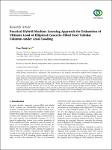Browsing by Author Tien-Thinh Le
Showing results [4 - 6] / 6
In this study, a hybrid machine learning (ML) technique was proposed to predict the bearing capacity of elliptical CFST columns under axial load. The proposed model was Adaptive Neurofuzzy Inference System (ANFIS) combined with Real Coded Genetic Algorithm (RCGA), denoted as RCGA-ANFIS. The evaluation of the model was performed using the coefficient of determination (R2) and root mean square error (RMSE). The results showed that the RCGA-ANFIS (R2 = 0.974) was more reliable and effective than conventional gradient descent (GD) technique (R2 = 0.952). The accuracy of the present work was found superior to the results published in the literature (R2 = 0.776 or 0.768) when predicting the... |
This work aims to develop a novel and practical equation for predicting the axial load of rectangular concrete-filled steel tubular (CFST) columns based on soft computing techniques. More precisely, a dataset containing 880 experimental tests was first collected from the available literature for the development of an artificial neural network (ANN) model. An optimization strategy was conducted to obtain a final set of ANN’s architecture as well as its weight and bias parameters. The performance of the developed ANN was then compared to current codes (AS, EN, AIJ, ACI, AISC, LRFD, and DBJ) and existing empirical equations. The accuracy of the present model was found superior to the res... |
This paper reports the results of soft computing-based models correlating L and N-type Schmidt hammer rebound numbers of rock. A data-independent database was compiled from available measurements reported in the literature, which was used to train and develop back propagating neural networks, genetic programming and least square method models for the prediction of L-type Schmidt hammer rebound numbers. The results show that the highest predictive accuracy was obtained for the neural network model, which predicts the L type Schmidt hammer rebound number, with less than ±20% deviation from the experimental data for 97.27% of the samples. The optimum neural network is presented as a clos... |


